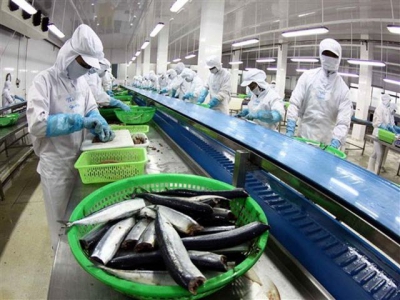Fishery exports reach US$ 9 billion

Fishery exports in 2018 reached about US$ 9 billion, increasing by 8.4% compared to 2017, in which, Tra fish was US$ 2.26 billion, up 26.4%; shrimp was US$ 3.58 billion; tuna was US$ 785 million and other fish was US$ 1.52 billion; mollusk was US$ 785 million.
Fishery is processed for exports. Photo: H.P
It was announced by the Directorate of Fisheries (Under the Ministry of Agriculture and Rural Development) at the conference summarizing the working performance in 2018 and deployment of the tasks in 2019 on 24 December in Ha Noi.
According to the Directorate of Fisheries, notably, the Tra fish exports not only gained an impressive export growth in 2018, but also recorded a remarkable growth in farming area with 5,400 ha (up 3.3% compared to 2017); and the output of 1.42 million tons, an increase of 8.4% compared to 2017.
In 2018, the Fishery sector has replaced 30,000 parent fishes, and enhanced the breeding stock selection. Thereby, the quality of Tra seed has been gradually improved, and the production of breeding stock and Tra fish product farming have basically been controlled to prevent the massively expanding spontaneous fish farming area since 2017.
Regarding marine farming (marine fish, mollusk, lobster, seaweed, crab ...) in 2018, the whole industry continued to develop with an area of about 6,000 ha of marine fish farming, with an output of 32 thousand tons; mollusks with 45 thousand hectares, output of 320 thousand tons; lobster output of 1.6 thousand tons, crab with more than 60 thousand tons...
In addition, the farming of high economic value species such as cold water fish, tilapia, mollusks, giant freshwater shrimp and lobster, has developed stably, contributing to improving the quality and value of the industry.
Although achieving positive results, but Mr. Tran Dinh Luan, Deputy Director of the Directorate of Fisheries also stated that in 2018, the whole industry still has some shortcomings and inadequacies. Typically, in the field of aquaculture farming, the quality of Tra seed has only had an minor improvement. The low quality of fish seed therefore leads to long-term consequences for the competitiveness of products. In addition, shrimp seed is still dependent heavily on imports, which may be affected by the manipulation on the market by countries or exporters.
“In addition, a number of potential products have not been developed to match potential or are unstable such as marine fish farming, seaweed farming, lobster farming and tilapia farming. The management of supplies used in aquaculture farming has changed, however, many farmers have used antibiotics and chemicals in aquaculture farming, ” Mr. Luan said.
For the exploitation, Mr. Luan added that the transfer of occupational structure in seafood exploitation is still slow, the occupations that are harmful for the fishery industry have not yet significantly decreased, especially in the Trawling Industry; the application of technical advances in fisheries exploitation is not high; the technology equipment for exploitation and preservation of products has not been invested, so the post-harvest losses are still high, affecting production efficiency and food safety.
Besides, the investment in infrastructure development for fishery sector has not yet been prioritized. The system of water supply and drainage, electricity supply, traffic in the areas of seed production and aquaculture farming is still inconsistent, causing difficulties for production, not attracting investors for development of aquaculture farming on an industrial scale and large goods volume.
For 2019, the Fishery sector set a target that the growth rate of production value is 4.25% compared to 2018; total fishery output is VND 7.9 million tons (exploiting is 3.6 million tons and farming with 4.3 million tons)
In order to achieve the target, the entire sector has continuously restructured and promoted the production under value chain (developing a scheme to link the value chains in production and consumption of major products); effectively deployed “the National Action Plan for the development of Vietnam’s Shrimp sector by 2025” and the Scheme for the development of Shrimp sector by 2025”; submitted for the approval and implementation of the Strategy for development of marine farming by 2025 and vision to 2045; and deployed contents of the Tra fish scheme at 3 levels.
Có thể bạn quan tâm
 Vietnam targets 10 billion USD from aquatic product exports in 2019
Vietnam targets 10 billion USD from aquatic product exports in 2019 Minister of Agriculture and Rural Development Nguyen Xuan Cuong has called for more efforts to push aquatic product export turnover to 10 billion USD in 2019.
 Cage fish farming – a good choice for sustainable poverty reduction in Vay Nua commune
Cage fish farming – a good choice for sustainable poverty reduction in Vay Nua commune Cage fish farming has helped Xa Van Dang’s family in Tham hamlet, Vay Nua commune (Da Bac district) earn over 100 million VND in profit a year.
 Tra fish exports surge to set new record
Tra fish exports surge to set new record Tra fish exports posted an impressive growth rate of 26.4 percent this year to hit a record of 2.26 billion USD